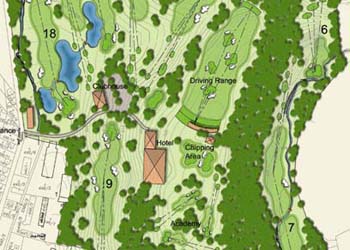Going the Distance: how many miles in a golf course?
Understanding the Length of a Golf Course is essential for players and enthusiasts alike. A golf course is a meticulously designed area consisting of 9 or 18 holes, each presenting unique challenges and landscapes. To measure a golf course accurately, specific techniques are employed. These measurements take into account various factors, including the distance between holes, hazards, and terrain. Two units commonly used to measure golf courses are yards and meters.

When it comes to determining how many miles are in a golf course, it is important to note that a standard 18-hole golf course typically ranges from 5,000 to 7,000 yards. Converting this to miles, it equates to approximately 2.84 to 3.98 miles. However, it is crucial to understand that the length of a golf course can vary based on several factors. These factors include the design and layout of the course, the presence of water bodies or hills, and the specific skill level the course targets.
The length of a golf course matters for several reasons. It affects the level of challenge and difficulty experienced by players, as longer courses usually require more powerful shots and strategic gameplay. The length can impact the speed of play, as longer courses may take more time to complete compared to shorter ones.
When considering a golf course, it is essential to also take into account other factors such as par and yardage, slope rating and course rating, and the overall layout and strategy of the course. These factors contribute to the overall playing experience and can greatly impact a player’s performance.
Key takeaway:
- Understanding the Length of a Golf Course: The length of a golf course is an important factor that affects gameplay and strategy.
- How Many Miles in a Golf Course: The standard length of a golf course can vary, but it is typically measured in miles, with factors such as layout and yardage influencing the final distance.
- Why Does the Length of a Golf Course Matter: The length of a golf course impacts gameplay difficulty and challenges golfers to use different clubs and tactics to navigate the course effectively.
Understanding the Length of a Golf Course
When it comes to understanding the length of a golf course, there are several important factors to consider. Here are some key points to keep in mind:
1. The total yardage of a golf course is a crucial aspect to consider. A standard 18-hole golf course typically ranges from 5,000 to 7,000 yards in length. The length can vary depending on the course design and level of difficulty.
2. The yardage of each individual hole is also significant. Holes on a golf course can range from around 100 yards to over 600 yards. The variety in hole lengths adds to the challenge and excitement of the game.
3. Par is another factor to consider. Par is the predetermined number of shots a skilled golfer is expected to take to complete a hole or a round. Most 18-hole golf courses have a par of 72, which means the total number of shots is expected to be close to this number.
4. It is essential to understand that different golf courses cater to different skill levels. Some courses are designed to be more challenging and may feature longer yardages, while others are designed to be more beginner-friendly with shorter yardages.
5. The length of a golf course can impact strategy and club selection. Longer courses may require more powerful shots, while shorter courses may demand more precision and accuracy.
6. Understanding the length of a golf course can help you assess your own abilities and choose courses that align with your skill level and preferences. If you are a beginner, it might be wise to start with shorter courses to build confidence and gradually progress to longer ones.
What is a Golf Course?
A golf course is a specially designed area where the sport of golf is played. It consists of a series of holes, usually 18 in total, each comprising a tee box, fairway, rough, and green. Let’s explore the various elements that make up a golf course.

1. Tee Box: The tee box is the starting point of each hole. It is where golfers begin by placing their ball on a small, flat surface called a tee, and take their first shot towards the fairway.
2. Fairway: The fairway is a neatly manicured area that leads from the tee box to the green. It is usually kept short and offers a smooth surface for golfers to hit their shots with precision.
3. Rough: The rough surrounds the fairway and is characterized by longer grass and thicker vegetation. It provides a greater challenge for golfers as shots from the rough require more skill and accuracy.
4. Green: The green is a small and finely mowed area at the end of each hole. It is where the hole and flagstick are located. The grass on the green is cut very short, allowing golfers to putt their balls into the hole to complete the hole.
5. Hazards: Golf courses may also have hazards strategically placed throughout. These can include bunkers filled with sand, water bodies such as lakes or ponds, and dense vegetation. Hazards are designed to test the golfer’s skill and add challenge to the game.
6. Maintenance: Golf courses require regular maintenance to ensure their quality. This includes mowing the grass, keeping the fairways and greens in good condition, maintaining bunkers, and watering the course to keep the grass healthy.
7. Layout and Design: Golf courses come in various layouts and designs. Some may have a more traditional or classic design, while others might incorporate unique features, such as undulating fairways or elevated greens. The design of a golf course greatly impacts the overall playing experience.
How are Golf Courses Measured?
Golf courses may seem vast and endless, but have you ever wondered how they are actually measured? In this section, we will uncover the secrets behind the measurement of golf courses. From exploring various units used in measuring these lush green landscapes to understanding the techniques employed, we’ll dive into the fascinating world of golf course measurements. Get ready to be amazed by the precision and attention to detail required in bringing these sprawling courses to life!

1. The Measurement of a Golf Course
One of the key aspects of understanding a golf course is knowing how it is measured. The measurement of a golf course involves considering several factors that contribute to its overall length and layout.
| Factor | Description |
| 1. Hole Yardage | The yardage of each hole is measured from the tee box to the green. This takes into account the distance golfers need to hit their shots to complete each hole. |
| 2. Course Rating | The course rating indicates the difficulty of a golf course for a scratch golfer. It takes into account various factors such as length, obstacles, and overall design of the holes. |
| 3. Slope Rating | The slope rating measures the relative difficulty of a course for the average golfer compared to a scratch golfer. It takes into account factors such as hazards, elevation changes, and green size. |
| 4. Par | The par of a golf course is the number of shots an expert golfer is expected to take to complete each hole and the entire course. It helps golfers understand the overall challenge of the course. |
| 5. Course Layout | The layout of a golf course considers the arrangement of holes, including the positioning of hazards, trees, and other obstacles. A well-designed layout can enhance the overall experience for golfers. |
When measuring a golf course, these factors are taken into consideration to provide golfers with a comprehensive understanding of the course’s length and difficulty. It allows players to determine the suitable level of challenge and select courses that align with their skill level and preferences.
By considering the measurement factors such as hole yardage, course rating, slope rating, par, and course layout, Tom created a masterpiece loved by golfers worldwide. His dedication to the precise measurement of the course showcased his expertise in designing a golfing experience that was both enjoyable and challenging. As a result, the golf course became a favorite among players, and its reputation soared within the golfing community.
2. Different Units Used to Measure Golf Courses
To accurately measure golf courses, various units of measurement are used. These units provide important information about the length and size of a golf course. The table below illustrates the different units used to measure golf courses:
| Unit of Measurement | Description |
| Yard | The yard is a common unit of measurement used in golf courses. It represents the distance between points on the course and is equivalent to 0.9144 meters. Most golf courses have yardage markers to indicate the distance from tee to green. |
| Meter | The meter is an international unit of measurement widely used in golf courses outside of the United States. It is equivalent to approximately 1.094 yards. Golfers from countries that use the metric system are more accustomed to measuring distances in meters. |
| Foot | The foot is another unit used to measure distances on golf courses. It is commonly seen on scorecards and represents one-third of a yard or 0.3048 meters. Some golfers prefer using feet as it provides a more precise measurement in certain situations. |
| Mile | While not frequently used to measure the entire length of a golf course, miles are occasionally used to measure longer distances within the course. A mile is equal to 1,760 yards or approximately 1.609 kilometers. |
Each of these units offers a different perspective on the size and length of a golf course. The choice of unit depends on the region, tradition, and individual preferences. Golfers should be familiar with these units to accurately understand the distances involved in playing each hole.
Understanding the different units used to measure golf courses ensures golfers have a comprehensive understanding of the course layout and can strategically plan their shots. Whether it’s measuring distances to avoid hazards or selecting appropriate clubs for the desired yardage, knowledge of these units enhances the golfing experience.
Please note that while the table above highlights the common units used to measure golf courses, specific dimensions and measurements may vary depending on the course and country. It’s essential to consult course maps, scorecards, and official guidelines for accurate measurements when playing golf.
How Many Miles in a Golf Course?
In this section, we’ll uncover the standard length for a golf course, providing insights into the typical distance golfers navigate. Then, we’ll uncover the factors that influence the length of a golf course, shedding light on the various elements that impact the overall distance players encounter. Get ready to tee off into the realm of golf course measurements!

1. Standard Length for a Golf Course
The standard length for a golf course is an important aspect that golfers consider when choosing where to play. Here are some key points to understand about the standard length of a golf course:
- Golf courses can vary in length depending on their design and purpose. The standard length for an 18-hole golf course is typically around 6,000 to 7,000 yards.
- The length of a golf course is measured by the total distance from the tee box of the first hole to the green of the 18th hole.
- The standard length of a golf course is influenced by various factors such as the skill level of the golfers, the type of golf course (e.g., championship course or executive course), and the location of the course.
- Professional golf courses, where major tournaments are held, tend to have longer standard lengths to provide a challenge for the world’s best golfers. These courses can exceed 7,000 yards.
- On the other hand, shorter standard lengths are often found in executive or par-3 courses, which are designed for beginners or golfers who prefer a quicker and less demanding round of golf.
- It’s worth noting that the standard length of a golf course can be further adjusted by the use of tees. Different tee boxes provide varying distances, allowing golfers of different skill levels to enjoy the course at an appropriate level.
Considering the standard length for a golf course is essential for golfers to plan their strategy, select appropriate clubs, and gauge their overall performance. It also allows golfers to compare their scores and skill levels with others who have played on courses of similar length.
When choosing a golf course to play, it’s important to consider your own skill level, preferences, and what type of experience you are seeking. Whether you enjoy the challenge of a longer course or prefer a more relaxed round on a shorter course, there are numerous options available to satisfy every golfer’s needs.
2. Factors Affecting the Length of a Golf Course
When it comes to the length of a golf course, there are several factors that can affect the overall distance. These factors, which include course design, location and terrain, weather conditions, type of grass, and altitude, play a significant role in determining the length of a golf course.
The course design, determined by the architect, influences the placement of the tees, fairways, and greens, which in turn affects the distance between each hole.
Location and terrain also have an impact on the length of a golf course. Courses built in hilly areas or with uneven terrain often have longer distances between holes compared to courses on flat terrain.
Weather conditions, such as wind direction and speed, can influence the length of a golf course. A strong headwind can make the holes play longer, while a tailwind can shorten the overall distance.
The type of grass on a golf course can also affect the distance a golf ball travels. Courses with faster fairways and greens may require longer shots, whereas courses with slower grass may allow for shorter shots.
Additionally, altitude plays a role in determining the length of a golf course. Courses at higher altitudes tend to have longer distances due to the thinner air, resulting in less ball carry and less overall distance.
Considering these factors can help golfers understand why a course has a particular length and enable them to strategize their approach on each hole accordingly. It is important to note that golf courses can vary in length, and the factors affecting length may differ from course to course.
When playing on a golf course, it is helpful to be aware of these factors and adjust your game accordingly. For example, if the course is known for its longer distances, you may need to use different clubs or adjust your swing to compensate. Conversely, if the course is shorter, you may have the opportunity to be more aggressive in your play.
The length of a golf course matters because it’s like trying to run a marathon in clown shoes – it’s going to be a challenge!
Why Does the Length of a Golf Course Matter?
The length of a golf course is an essential aspect that impacts the game and overall experience. Understanding the reason behind why the length of a golf course matters can assist golf players in making informed decisions and enhancing their performance.
1. The challenge of the game: Golfers face a greater challenge on longer golf courses. They need to hit longer shots, navigate tougher hazards, and strategize their approach to each hole. This increased difficulty pushes players to enhance their skills and make more precise shots.
2. Playing conditions: The length of a golf course is often connected to the terrain and environmental factors. Longer courses typically feature a more varied landscape, including hills, bunkers, and water hazards. These elements add complexity to the game and require players to carefully consider their shot selection.
3. Skill level and experience: The length of a golf course should be suitable for a player’s skill level. Beginners or high-handicap players may find longer courses overwhelming and struggle to reach the greens in regulation. Conversely, skilled players may seek longer courses to test their abilities and experience a more challenging game.
4. Playing time: Longer golf courses tend to take more time to complete. This can impact the pace of play and overall enjoyment of the game. Players should consider their available time and preferences when choosing a golf course based on its length.
5. Tournament play: The length of a golf course often plays a significant role in professional tournaments. Major championships set up the course length to provide a suitable challenge for the world’s best players. The longer distance forces them to utilize their skill and make strategic decisions to succeed.
6. Course rating: The length of a golf course is a crucial factor in determining its course rating. Course rating is a measure of the difficulty of a golf course for a scratch golfer. The length, along with other factors such as the layout and hazards, contributes to the course rating and helps golfers assess the potential challenge.
Other Factors to Consider in a Golf Course
When it comes to golf courses, there’s more than meets the eye. In this section, we’ll uncover the other factors that play a crucial role in creating the perfect golfing experience. From understanding the par and yardage to navigating the course layout and strategy, we’ll explore how these elements can make or break your game. So get ready to dive into the world of golf, where every detail counts and every decision shapes your next swing!
1. Par and Yardage
To fully comprehend a golf course, it is essential to grasp the concept of par and yardage. Par represents the number of shots an experienced golfer is expected to take to complete a hole or an entire round. Yardage, on the other hand, refers to the length of each hole, typically measured in yards. These two factors play a crucial role in determining the difficulty and strategy of a golf course.
In order to provide a comprehensive understanding of par and yardage, let’s take a look at the following table:
| Hole Number | Par | Yardage |
| 1 | 4 | 400 |
| 2 | 3 | 150 |
| 3 | 5 | 550 |
As seen in the table, each hole has a designated par value, ranging from three to five, depending on its difficulty. The total par for a golf course is calculated by summing up the par values of all the holes. Similarly, yardage varies from hole to hole, offering players a diverse range of distances to cover.
Par and yardage contribute to the overall challenge and enjoyment of a golf course. Courses with higher par values and longer yardages require players to execute more shots accurately, testing their skill and strategizing abilities. Conversely, courses with lower par values and shorter yardages might provide beginners or less experienced players with a more manageable challenge.
While choosing a golf course, it is crucial to consider your skill level and desired level of difficulty. If you are a beginner, selecting a course with a lower par value and shorter yardages might be more suitable. On the other hand, if you are an experienced golfer seeking a greater challenge, opt for courses with higher par values and longer yardages.
Remember to focus on your game and enjoy the beauty of the course as you strive to improve your skills. Happy golfing!
Golf course ratings: Because numbers can’t tell you how many strokes you’re really going to lose.
2. Slope Rating and Course Rating
Slope Rating and Course Rating are important factors to consider in a golf course. These ratings provide valuable information for golfers to understand the challenges and suitability of a particular course.
Slope Rating: Slope rating is a measure of the relative difficulty of a golf course for a bogey golfer compared to a scratch golfer. It is expressed as a whole number from 55 to 155. A higher slope rating indicates a more challenging course. Golfers should consider their skill level when choosing a course with an appropriate slope rating that aligns with their abilities.
Course Rating: Course rating represents the expected number of strokes it should take a scratch golfer to complete a golf course. It is expressed as a number rounded to one decimal place. A lower course rating indicates an easier course, while a higher course rating signifies a more challenging course. Course rating is an objective measure that helps golfers assess the difficulty of a course and compare it to others.
Slope rating and course rating are crucial in determining the appropriate level of challenge and enjoyment for golfers. Higher slope ratings correspond to more difficult courses, while lower course ratings indicate easier courses. It is essential for golfers to consider these ratings when selecting a course that matches their skill level and preferences. Additionally, understanding slope rating and course rating can assist golfers in improving their game by challenging themselves appropriately and setting realistic expectations.
3. Course Layout and Strategy
The course layout and strategy are essential aspects of playing golf successfully. By understanding the layout of the course and employing effective strategies, golfers can improve their performance and achieve better scores.
| Course Layout | Course Strategy |
| 1. The course layout refers to the physical design and arrangement of the holes on the golf course. It includes factors such as the length and placement of each hole, the positioning of hazards and bunkers, and the overall landscape and terrain of the course. | 1. The course strategy involves planning and executing shots to navigate the course successfully. It requires golfers to make strategic decisions on club selection, shot placement, and shot execution. |
| 2. A well-designed course layout will offer a variety of challenges and opportunities. It may feature doglegs, water hazards, bunkers, and undulating greens, all of which require careful consideration and strategy. | 2. Effective course strategy involves assessing the risks and rewards of different shot options. Golfers need to consider factors such as hole length, wind conditions, hazards, and the position of their ball in relation to the target. |
| 3. The course layout can influence the overall difficulty and playability of the course. Courses with strategic design elements provide an enjoyable and challenging experience for golfers of all skill levels. | 3. Strategic shot selection and execution can help golfers navigate the challenges presented by the course layout. It may involve playing conservatively to avoid hazards or taking calculated risks to gain a competitive advantage. |
| 4. Familiarizing oneself with the course layout is crucial for developing an effective strategy. By studying the course map, yardages, and hole diagrams, golfers can plan their shots and make informed decisions during gameplay. | 4. Adapting the strategy based on the specific conditions of each hole is essential. Golfers should consider factors such as wind direction, pin placement, and the location of hazards when formulating their approach. |
Pro-tip: Practice playing different courses with varying layouts and experiment with different strategies to improve your overall game. Pay attention to how other skilled players approach each hole, as it can provide valuable insights into effective course strategies. With time and practice, you’ll develop a better understanding of course layout and strategy, leading to improved performance on the golf course.
Some Facts About How Many Miles in a Golf Course:
- ✅ The average distance walked during a round of golf is 6.6 miles. (Source: The R&A)
- ✅ The shortest distance walked during a round of golf was 5.7 miles. (Source: The R&A)
- ✅ The longest distance walked during a round of golf was 7.8 miles. (Source: The R&A)
- ✅ Walking the course on hilly terrain can double the distance walked during a round of golf. (Source: Golf Reviews Pro)
- ✅ Some professional golfers log upwards of 10 million steps in a single season. (Source: Golf Reviews Pro)
Frequently Asked Questions
How many miles does the average golfer walk in a round of golf?
The average distance walked during a round of golf is 6.6 miles, which is 69% greater than the scorecard yardage alone.
What factors contribute to the distance walked in a round of golf?
Factors that contribute to the distance walked include the length of the course, the walks from greens to tees, the route taken to the hole, the amount of time spent searching for balls, and the time spent on and around the greens.
Is there a difference in distance walked based on whether a golfer carries their own clubs or uses a cart?
Carrying a set of clubs may reduce the distance walked compared to using a cart, but it can put more strain on the body. It ultimately depends on the golfer’s preference and physical capabilities.
What is the longest golf course in the world and how long would it take to walk?
The longest golf course in the world is Chambers Bay in Washington state, which is 8,164 yards long. If a player walks at a moderate pace of three miles per hour, it would take them over six hours to finish the entire course.
Do professional golfers walk a significant distance during a season?
Yes, some professional golfers have been known to log upwards of 10 million steps in a single season.
What are the health benefits of walking a golf course?
Walking the golf course can improve stamina, endurance, and provide a better feel for the layout of the holes. It also helps improve focus, prevents fatigue, and provides exercise.






![Unlocking the Secret to Choosing the Best Golf Drivers for Mid Handicappers [2024]](https://www.fairwayfindings.com/wp-content/uploads/2024/03/Choosing-the-Best-Golf-Drivers-for-Mid-Handicappers-768x768.webp)
